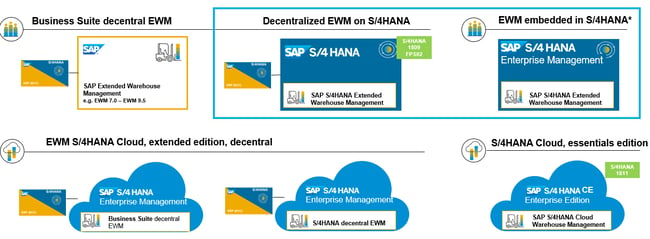The Differences Between SAP EWM Decentralized vs. Embedded
SAP Extended Warehouse Management (EWM) offers warehouses a comprehensive solution for managing warehouse operations from goods receipt, reversals, storage optimization, picking and packing, kitting, route determination, labor management, and more. Warehouses use SAP EWM to create streamlined process flows, resulting in operational efficiency, faster fulfillment and throughput, and greater cost control. However, the deployment model –– SAP EWM decentralized vs embedded –– can impact functionality.
What Are Embedded EWM and Decentralized EWM?
Since SAP released Extended Warehouse Management in 2005, it has offered different deployment options. It was originally decentralized, based on SCM Business Suite. However, SAP allows users to deploy SAP EWM embedded as part of a warehouse’s S/4HANA enterprise management solution or decentralized on a separate instance connected to S/HANA or SAP ECC.
SAP S/4HANA Supply Chain Management for Extended Warehouse Management (embedded EWM) is a default offering in SAP S/4HANA 1610 and is included in the license cost. Embedded EWM has two versions, “Basic” and “Advanced.” Basic will replace SAP WM, which will sunset in 2025, but has additional functions, such as layout- and process-oriented management, expanded reporting capabilities, and resource management. Advanced, which requires additional licenses, includes wave management, yard management, cross-docking, kitting and slotting, billing, labor management, and other functionality.
In the decentralized model, SAP EWM is deployed on a separate server and connected to SAP S/4HANA with remote function calls and core interface (CIF).

Source: SAP Regional Implementation Group (RIG)
An SAP EWM Decentralized vs Embedded Comparison
Both deployment options allow users to add new functionality over time and utilize SAP transactional data, document types and master data. However, there are several differences between them:
- Scalability: Embedded EWM connects to one SAP ERP or SAP S/HANA system. Decentralized EWM can integrate with multiple SAP ERP systems at a single or multiple locations. Warehouses may also use a decentralized deployment model during a transition from SAP ECC to SAP S/4HANA until all custom legacy applications are modernized and transitioned.
- Integration: Technically, embedded EWM allows for easier integrations with production planning and S/4HANA and a simplified system footprint. However, integration with warehouse automation systems is a driver of decentralized EWM.
- Simplicity: With embedded EWM, partner data, material master data, and batch master data don’t have to be replicated because they exist in SAP S/4HANA. It also eliminates the Expected Goods Receipt (EGR) document because SAP S/4HANA can read that data directly.
- Agility: Decentralized EWM gives more flexibility to upgrade and add functionality independently from SAP’s roadmap.
- Uptime: If a warehouse operates around the clock, 365 days per year, and has a high-volume operation on the order of hundreds of thousands of units per day, decentralized EWM is likely the better choice. It can keep the warehouse running even if the ERP system is down.
You can review the finer points of the differences between SAP EWM Decentralized vs. Embedded Comparison in SAP note 2840129, which is updated regularly.
SAP EWM Decentralized vs Embedded and the Cloud
Warehouses transitioning management from an on-premises system to a cloud or hybrid system need to evaluate which deployment model will benefit them now, throughout the transition, and when they’re fully operating in their new IT environments. Considering the impact the decentralized EWM or embedded EWM deployment will have on functionality and performance is essential. This analysis is particularly vital if your warehouse operation is complex, has a high throughput, or planning to deploy robotics or other automation solutions.
Do You Have a Choice?
When you dig deeper into the differences between SAP S/4HANA Embedded EWM vs. Decentralized EWM, the right deployment model for your warehouse will be clear. The total cost of ownership will be a major factor in your decision. Because Basic Embedded EWM is included with the SAP S/4HANA license, the option can keep costs low. However, if it doesn’t provide the functionality your warehouse needs, settling for Basic when you need much more could cost you more in the long run when you factor in efficiency, automation options, labor costs, business continuity, and competitiveness.
However you resolve the SAP EWM decentralized vs. embedded question, there’s one more thing to consider: mobility. SAP EWM doesn’t enable warehouse workers to use mobile devices to enter data at the point of task and give managers real-time visibility into operations and inventory. For those advantages, you need a platform like Pillir that is designed with deep integration with SAP while keeping your core clean.
Furthermore, Pillir’s low-code/no-code platform allows you to create custom apps quickly and easily with a drag-and-drop interface. Pillir also provides extreme offline capabilities, so employees have the same user experience whether they’re connected to the network or not –– and synchronizes data without errors with the connection is restored. Additionally, your team can use Pillir’s Warehouse Management suite of mobile and web applications out of the box, no coding required.
Want to learn more on SAP EWM Decentralized vs Embedded?
Consider all SAP EWM deployment options and solutions available to provide your warehouse with the functionality it needs. Contact Pillir to learn more.






 Back
Back/Logo%20-%20black%20text%20blue%20pillar%20(large)-1.jpg)

